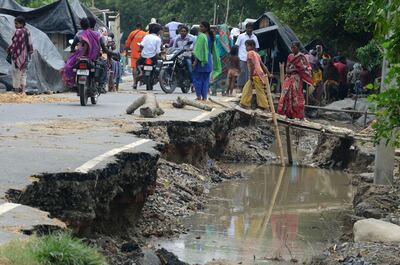Flooding caused by heavy monsoon rains has affected more than 16 million people in South Asia, with more than 340 people killed so far, officials and aid workers said.
The heavy rains and damaged roads are also hampering efforts to tackle severe food shortages and a growing risk of waterborne diseases in affected areas of Nepal, Bangladesh and India.
"This is fast becoming one of the most serious humanitarian crises this region has seen in many years," said Martin Faller, deputy regional director for Asia Pacific at the International Federation of Red Cross and Red Crescent Societies.
"Millions of people face severe food shortages and disease. We fear it will get worse in the days and weeks ahead."
More than a third of Bangladesh and Nepal have been flooded, Mr Faller said.
In Nepal, 27 of 75 districts were either submerged or hit by landslides, leaving villages and communities stranded without food, water and electricity.
Nepal' home ministry said 131 people had been killed and 30 were missing.
"We need donors' assistance and support from social organisations," the ministry said.
Aid workers are rushing to deliver tarpaulins for temporary shelter, food and water, said Dev Ratna Dhakhwa, secretary general of the Nepal Red Cross Society.
Residents face severe food shortages as food crops have been wiped out in the worst floods in 15 years, he said.
The charity WaterAid said there was a high risk of a significant public health crisis from waterborne diseases such as cholera.
In Bangladesh, flood levels have reached record highs. At least 56 people have been killed and about 4 million are affected, the Red Crescent said on Thursday.
The situation could get worse as swollen rivers carry rainwater from neighbouring India downstream into the low-lying and densely populated country.
"The immediate situation is extremely desperate," Save the Children director Mark Pierce said.
"The sheer volume of water is also making it really difficult to access some of the communities most in need."
In India, more than 11 million people have been affected in four states across the north and east, with at least 156 killed.
"These are the worst floods in Assam in a decade," said Keshab Mahanta, relief and rehabilitation minister.

With relief operations hampered, food packets are being dropped from helicopters in the worst affected areas.
In a makeshift relief camp in Kaliabor, 160 kilometres east of Assam's main city of Guwahati city, families said they had not received any aid.
"We are practically starving, with no government supplies reaching us," said Arunima Dutta, a mother of three who is sheltering from the disaster with hundreds of others.
Residents are also at risk of contracting diseases such as malaria and Japanese encephalitis, the Red Cross warned.
India's meteorological department has forecast more heavy rain for the region in the coming days.
"Though we come to expect these rains every year, this year is particularly severe," said Murali Kunduru, Save the Children's India manager.

